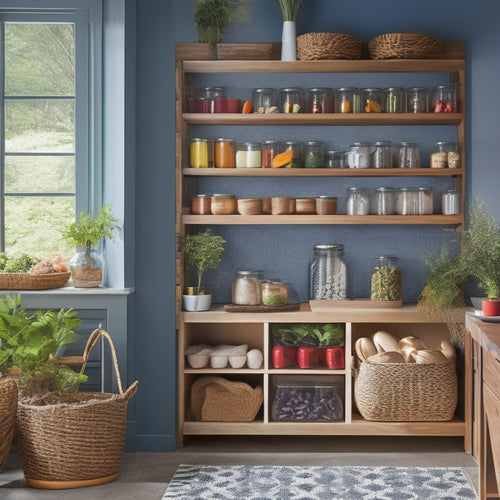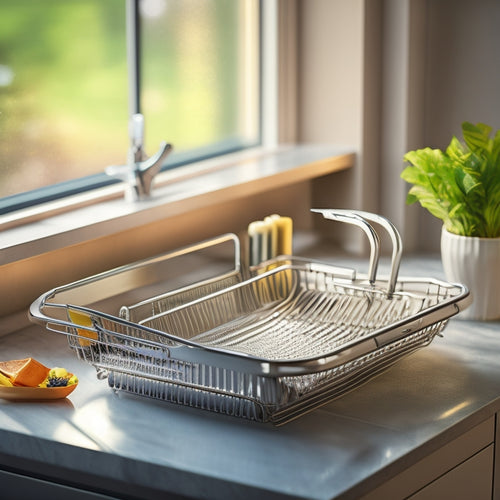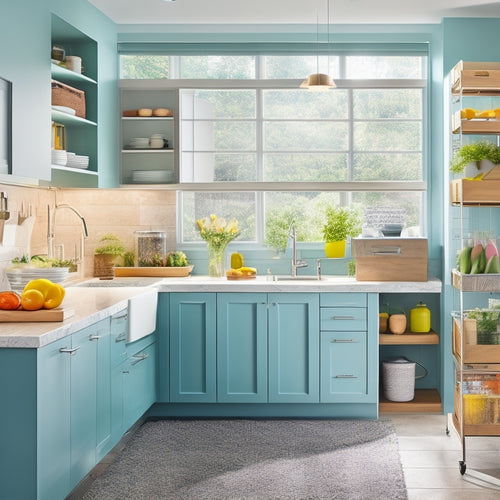
5 Best Canned Goods Storage Ideas for Kitchen
Share
You're tired of digging through your pantry or cabinet to find the canned goods you need. Stop the frustration with these 5 best storage ideas for your kitchen. First, optimize your vertical space with shelves and hooks. Next, label and categorize your cans for easy identification. Maximize your corner space with carousels or lazy Susans. Invest in stackable containers to keep similar items together. Finally, enhance your cabinet organization with dividers and adjustable shelves. By implementing these ideas, you'll be cooking up a storm in no time. Now, explore how to take your canned goods storage to the next level.
Key Takeaways
• Install floor-to-ceiling shelves and utilize hanging hooks to maximize storage and optimize vertical space for canned goods.
• Implement a clear labeling system and categorize cans alphabetically or by color for quick access and easy identification.
• Invest in stackable containers and label them for efficient storage, grouping similar items together and color coding for categorization.
• Optimize corner storage with carousels, lazy Susans, or pull-out drawers to reduce clutter and enhance accessibility.
• Assign specific shelves for different categories of canned goods and utilize drawer dividers and adjustable shelves for a cabinet organization system.
Utilize Vertical Space With Shelves
By installing shelves that stretch from floor to ceiling, you can maximize your storage capacity and keep your canned goods organized and easily accessible. This is especially useful for small kitchens where space is limited.
With floor-to-ceiling shelves, you can store more cans in a compact area, freeing up space for other essentials. Consider adding hanging hooks to hang items like baskets, bags, or even aprons, keeping them off the floor and out of the way.
To make the most of your shelves, use a rolling cart or a Lazy Susan to store cans that are near their expiration dates. This way, you can easily rotate them to the front of the shelf, ensuring you use the oldest items first.
Additionally, a cart or turntable allows you to access the cans at the back of the shelf without having to remove everything in front of them. By utilizing vertical space with shelves and incorporating hanging hooks and a rolling cart, you'll be able to store your canned goods efficiently and safely.
Label and Categorize Canned Goods
Your canned goods storage system isn't complete without a clear labeling and categorization system, which helps you quickly identify what you have and guarantees you use the oldest items first. This secures you consume the oldest items before they expire, reducing food waste and keeping your kitchen safe.
To create an effective labeling and categorization system, consider the following strategies:
| Categorization Method | Description | Benefits |
|---|---|---|
| Alphabetical Organization | Organize cans by product name (e.g., beans, corn, tomatoes) | Easy to find specific items, promotes inventory management |
| Color Coding | Use colored labels or stickers to categorize cans by type (e.g., red for meats, green for vegetables) | Visual differentiation, quick identification |
| Customized Labels | Create labels with product name, expiration date, and storage location | Personalized organization, easy inventory tracking |
Maximize Corner Storage Potential
Optimize your pantry's often-wasted corner space by installing a carousel or lazy Susan, allowing you to easily access and view canned goods that would otherwise be hard to reach. This clever storage solution ensures you can see everything at a glance, reducing clutter and making meal prep a breeze.
Consider adding pull-out drawers or shelves to maximize corner storage. These allow you to retrieve items without having to search through the entire pantry, reducing the risk of accidents or spills.
For added convenience, hang wire racks or baskets from the ceiling or walls to store infrequently used items, keeping them out of the way but still easily accessible.
Invest in Stackable Containers
Stack canned goods efficiently with stackable containers. These containers can be labeled and arranged to create a visually appealing and easily navigable storage system. This will help you quickly identify what you have and where it's located.
You can group similar items together, such as vegetables or meats, and label each container accordingly. To take it a step further, consider color coding your labels to categorize items by type or expiration date. This will make it easy to implement a pantry rotation system, where you use the 'first in, first out' rule to guarantee older items are consumed before newer ones.
When choosing stackable containers, look for ones that are durable, easy to clean, and have a secure lid to prevent spills and messes. You can also consider containers with built-in dividers or compartments to separate items within the same category.
Optimize Cabinet Organization Systems
Six cabinet shelves can quickly become cluttered with canned goods, making it essential to implement a strategic organization system to maximize storage capacity and accessibility.
You can start by categorizing your canned goods into groups, such as vegetables, fruits, meats, and soups. Assign a specific shelf or section to each group, and use labels to identify them easily.
To make the most of your cabinet space, consider installing drawer dividers or adjustable shelves. These will help you create separate compartments for different types of canned goods, keeping them organized and preventing them from getting jumbled.
You can also use magnetic strips to store small items like spices, oils, or condiments on the side of a cabinet or fridge.
Frequently Asked Questions
How Often Should I Rotate My Canned Goods to Ensure Freshness?
Imagine a can of expired beans lurking in the shadows, waiting to spoil your meal. You should rotate your canned goods every 6-12 months to guarantee freshness, checking expiration dates and storing newer items behind older ones.
Can I Store Canned Goods in a Hot Attic or Garage?
You shouldn't store canned goods in a hot attic or garage, as extreme temperatures can affect shelf life. Instead, opt for temperature control with attic storage solutions or garage shelving that keep cans away from direct heat sources.
Are Glass Containers Safe for Storing Canned Goods?
"You're probably thinking glass containers are a great idea, but beware - canning jars can be risky for storing canned goods due to potential breakage and contamination. Consider alternative storage options for a safer bet."
Can I Store Canned Goods Near a Heat Source Like an Oven?
You shouldn't store canned goods near heat sources like an oven, as high temperatures can impact their proper storage and shelf life. Instead, choose a cooler, dry spot to guarantee your canned goods remain safe and fresh.
How Long Do Canned Goods Typically Last Past Their Expiration Date?
As you navigate the uncertainty of expiration dates, remember that a treasure chest of properly stored canned goods can remain safe for years, with shelf life extension achievable through proper storage techniques, like cool temps and dry conditions, allowing you to savor them long after the expiration date.
Related Posts
-

Sliding Pantry Storage Ideas for Renters
If you're looking to optimize your rental kitchen, sliding pantry storage solutions could be your answer. Employ vert...
-

Rust-Resistant Dish Drainers for Long-Lasting Use
If you're looking for rust-resistant dish drainers, focus on materials like high-grade stainless steel for superior c...
-

Sink Storage Solutions for Open-Concept Kitchens
To maximize storage in your open-concept kitchen, focus on clever under-sink solutions and vertical space utilization...


